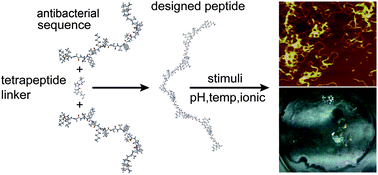Stimuli-responsive self-assembling peptides made from antibacterial peptides†
Abstract
How to use bioactive

* Corresponding authors
a
West China Hospital Nanomedicine Laboratory, West China Hospital, Sichuan University, Chengdu, China
E-mail:
xiaojunz@mit.edu
b Key Laboratory of Cell Engineering of Guizhou Province, Affiliated Hospital of Zunyi Medical College, Zunyi, China
c National Center for Nanoscience and Technology, Beijing 100190, China
d Center for Biomedical Engineering, Massachusetts Institute of Technology, Cambridge, USA
How to use bioactive

 Please wait while we load your content...
Something went wrong. Try again?
Please wait while we load your content...
Something went wrong. Try again?
Y. Liu, Y. Yang, C. Wang and X. Zhao, Nanoscale, 2013, 5, 6413 DOI: 10.1039/C3NR00225J
To request permission to reproduce material from this article, please go to the Copyright Clearance Center request page.
If you are an author contributing to an RSC publication, you do not need to request permission provided correct acknowledgement is given.
If you are the author of this article, you do not need to request permission to reproduce figures and diagrams provided correct acknowledgement is given. If you want to reproduce the whole article in a third-party publication (excluding your thesis/dissertation for which permission is not required) please go to the Copyright Clearance Center request page.
Read more about how to correctly acknowledge RSC content.
 Fetching data from CrossRef.
Fetching data from CrossRef.
This may take some time to load.
Loading related content
